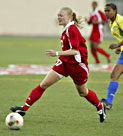Molson Stadium without Mother Nature
Molson Stadium without Mother Nature McGill University
User Tools (skip):
Molson stadium without Mother Nature
The grass is always greener on the other side. At McGill's newly renovated Molson Stadium, the grass is not only greener, it's safer, more durable and cheaper to maintain. It's also artificial.

McGill grad Amber Allen played for Team Canada in this summer's win against Brazil
Andrew Dobrowolskyj
FieldTurf, a synthetic grass touted as better than Mother Nature's version, is the centrepiece of the stadium's $12-million renovations. Made by a Montreal-based company by the same name, FieldTurf is in use around the world, for football, soccer, rugby, baseball and golf.
"I'm not against Mother Nature, but when it comes to a field that gets a lot of use you have to go with synthetic grass," says Robert Dubeau, director of athletics at McGill. "Without a doubt, real grass is the best playing surface —but only if you use it 10 or 12 times a year."
A real grass field can take a maximum of 20 hours of use per week. With the field being used by McGill's many intramural and intercollegiate programs, as well as the Montreal Alouettes, choosing FieldTurf was a "no brainer," says Dubeau.
"The only thing that deteriorates the field isn't use, it's the sun's UV rays," says Dubeau. The field has a life span of eight to 15 years and, weather permitting, the field can be used year-round.
The synthetic grass' durability puts it a step ahead of Mother Nature. The synthetic grass blades are made up of a hybrid polyethylene and polypropylene fibre, making it look and feel like real grass. Each blade is surrounded by an infill mix of graded silica sand and ground rubber to give the field a non-compactable, resilient, natural earth feel.
Durability also makes the field a safer alternative to real grass. The chance of motion-related injuries decreases because, unlike real grass, FieldTurf doesn't wear down after repeated use and has more give and cushioning than the Astroturf previously used at Molson Stadium.
Lower and cheaper mainten-ance is another advantage FieldTurf has over Mother Nature. "You don't have to cut the grass or water it and it looks like real grass," says Dubeau. Maintaining a real grass field can cost from $60,000 to $85,000 a year.
"It's better than real grass because it doesn't get muddy," says Chuck McMann, head coach of the McGill Redmen football team. Football is an all-weather sport, and a field guaranteed to be in good condition no matter the weather is a big plus for the players, adds McMann.
With all the renovations this summer, the hope is Molson Stadium will become a premier Canadian venue for football and soccer. Already home to the Montreal Alouettes, the stadium will be host to the 2003 and 2004 Canadian Interuniversity Sport soccer championships. This summer the stadium was host to an international friendly soccer match between Canada and Brazil.
Hosting concerts and cultural events in the near future are also in the plans for Molson Stadium. It's a shame Mother Nature will have to buy a ticket to catch all the action.
